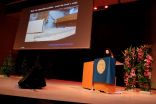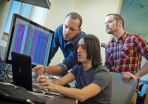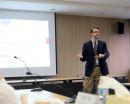(Press-News.org) Researchers have long wondered if there is an upper limit to our capacity to store memories and how we manage to remember so many events without mixing up events that are very similar.
To explore this issue, researchers at the Norwegian University of Science and Technology's (NTNU) Kavli Institute for Systems Neuroscience and Centre for Neural Computation and colleagues from the Czech Republic and Italy tested the ability of rats to remember a number of distinct but similar locations. Their findings are published in the 8 December edition of the Proceedings of the National Academy of Sciences of the United States.
The brain creates and stores memories in small networks of brain cells, with the memories of events and places stored in a structure called the hippocampus.
The researchers tested memory in seven laboratory rats by letting them run around in 11 distinct yet similar rooms over the course of two days. The freely running rats wandered around the rooms in pursuit of chocolate crumbs while researchers recorded brain activity in CA3 place cells in the hippocampus. As their name suggests, place cells are neurons that fire in a specific place.
The rooms were very alike, but the rats still managed to create a separate, independent memory, or a map for every environment, the researchers found.
The CA3 place cells the researchers recorded in the hippocampus continued to form unique representations for each environment.
The researchers also found that these unique representations or firing patterns were stored in the rats' memories so that when the animal was introduced to one of the rooms a second time, the spatial map from the rat's first exposure to the room was reactivated.
"We investigated whether these memories overlapped across some rooms, but all of the memories were completely independent," said the paper's first author, Charlotte Alme. "This indicates that the brain has an enormous capacity for storage. The ability to create a unique memory or map for every locale explains how we manage to distinguish between very similar memories and how the brain prevents us from mixing up events."
Alme says their findings also help explain why a specific memory trick called "the method of loci" works. This technique involves making a connection between things that you want to remember and places that you know quite well. By associating individual memories with different rooms in your house, for example, you can more easily recall what you need to remember by mentally walking through your house and visiting each room.
"Our paper shows that rats (and most likely humans) have a map for each individual place, which is why the method of loci works," she said. "Each place (or room in your house) is represented by a unique map or memory, and because we have so many different maps we can remember many similar places without mixing them up."
NTNU Professor and 2014 Nobel Laureate May-Britt Moser, who is the corresponding author of the paper, mentioned the research in her Nobel Lecture on 7 December in Stockholm and said that the findings were important for understanding episodic memory, or memories that are formed from autobiographical experiences.
The publication is a contribution by Professor Moser to a special series of Inaugural Articles being published by the journal in honor of those elected to the academy in 2014. Professor Moser and her husband, colleague and fellow Nobel Laureate Edvard Moser, were both elected as Foreign Associates of the US National Academy of Sciences in April.
INFORMATION:
Reference: Place cells in the hippocampus: Eleven maps for eleven rooms. Charlotte B. Alme, Chenglin Miao, Karel Jezek, Alessandro Treves, Edvard I. Moser, May-Britt Moser. Proceedings of the National Academy of Sciences. 8 December 2014.
http://www.pnas.org/cgi/doi/10.1073/pnas.1421056111
Technology that can map out the genes at work in a snake or lizard's mouth has, in many cases, changed the way scientists define an animal as venomous. If oral glands show expression of some of the 20 gene families associated with "venom toxins," that species gets the venomous label.
But, a new study from The University of Texas at Arlington challenges that practice, while also developing a new model for how snake venoms came to be. The work, which is being published in the journal Molecular Biology and Evolution, is based on a painstaking analysis comparing groups of ...
(BOSTON and CAMBRIDGE, Massachusetts) - One of the reasons cancer is so deadly is that it can evade attack from the body's immune system, which allows tumors to flourish and spread. Scientists can try to induce the immune system, known as immunotherapy, to go into attack mode to fight cancer and to build long lasting immune resistance to cancer cells. Now, researchers at the Wyss Institute for Biologically Inspired Engineering and Harvard's School of Engineering and Applied Sciences (SEAS) show a non-surgical injection of programmable biomaterial that spontaneously assembles ...
BUFFALO, N.Y. - A new study has shown that smoking can inhibit the success of treatment for alcohol abuse, putting people who are addicted to both tobacco and alcohol in a double bind.
According to findings by the University at Buffalo Research Institute on Addictions (RIA), clients who smoke have shorter stays in alcohol treatment programs than non-smokers and may have poorer treatment outcomes than non-smokers.
Kimberly Walitzer, PhD, deputy director and senior research scientist at RIA, led the study, which analyzed more than 21,000 adult treatment seekers from ...
PROVIDENCE, R.I. - Some infections after prostate biopsy due to drug-resistant Escherichia coli can be thwarted by simple rectal swab cultures prior to the procedure. The cultures test for antibiotic-resistant E. coli, and the findings are used to direct the selection of antimicrobial prophylaxis used for the procedure, according to Rhode Island Hospital researchers. The study was recently published in Urology.
For patients undergoing transrectal ultrasound (TRUS)-guided biopsies, Ciprofloxacin may not be the best prophylactic option to use for patients colonized with ...
NASA's Terra and Aqua satellites flew over Typhoon Hagupit from Dec. 6 through Dec. 8 and the MODIS instrument that flies aboard both satellites provided images of the storm as it moved through the country.
The Moderate Resolution Imaging Spectroradiometer or MODIS instrument aboard NASA's Aqua satellite caught a picture of Hagupit on Dec. 6 before it made landfall. On Dec. 7, the MODIS instrument aboard NASA's Terra satellite took an image of the storm as it was making landfall in the eastern Philippines.
On Dec. 8 at 04:50 UTC (Dec. 7 at 11:50 p.m. EST) when NASA's ...
Scientists at the Medical College of Wisconsin (MCW) have discovered a link between sleep loss and cell injury. Results of a new study find sleep deprivation causes the damage to cells, especially in the liver, lung, and small intestine. Recovery sleep following deprivation heals the damage.
The findings are published in the December issue of Sleep, a joint publication of the Sleep Research Society and the American Academy of Sleep Medicine. The lead author is Carol Everson, Ph.D., professor of neurology, cell biology, neurobiology and anatomy at MCW. Co-authors are Christopher ...
Athens, Ga. - New University of Georgia research shows that while on the job, public servants contribute not just to mandated sustainability but also to discretionary eco-friendly initiatives of their own.
"Some people are born with a higher intrinsic need to serve the public," said study co-author Robert K. Christensen, an associate professor in the School of Public and International Affairs. "They have a desire to help others and serve society. Government and nonprofit managers, for example, typically have higher levels of public service motivation than business managers."
The ...
Triple-negative breast cancer is as bad as it sounds. The cells that form these tumors lack three proteins that would make the cancer respond to powerful, customized treatments. Instead, doctors are left with treating these patients with traditional chemotherapy drugs that only show long-term effectiveness in 20 percent of women with triple-negative breast cancer. Now, researchers at The Johns Hopkins University have discovered a way that breast cancer cells are able to resist the effects of chemotherapy -- and they have found a way to reverse that process.
A report of ...
CLEVELAND: Researchers from Seidman Cancer Center at University Hospitals (UH) Case Medical Center and Case Western Reserve University School of Medicine presented new research findings this weekend at the 56th Annual Meeting of the American Society of Hematology (ASH) in San Francisco.
In a poster presentation (Abstract #4053), Jane Little, MD, and colleagues presented promising findings related to a novel biochip aimed at improving outcomes for patients with sickle cell disease. Although it is well-known that red cell interactions are important in sickle cell disease, ...
According to a new NOAA-sponsored study, natural oceanic and atmospheric patterns are the primary drivers behind California's ongoing drought. A high pressure ridge off the West Coast (typical of historic droughts) prevailed for three winters, blocking important wet season storms, with ocean surface temperature patterns making such a ridge much more likely. Typically, the winter season in California provides the state with a majority of its annual snow and rainfall that replenish water supplies for communities and ecosystems.
Further studies on these oceanic conditions ...





